
The Anki Method
XG2Anki

 |
The Anki MethodXG2Anki |

|
|---|
Anki is a freely available (open source) digital flashcard programme that can be downloaded for various platforms from here:
https://apps.ankiweb.net
Your desktop and mobile Anki apps can be synchronised very easily via a free Anki account:
https://ankiweb.net/account/register
The XG2Anki service developed by Rainer Birkle allows the fully automated creation of Anki decks from XG match and position files.
You can download several free decks via this website. In addition, many particularly valuable decks, such as theme decks from Super Grandmaster Dirk Schiemann's position database, are offered for sale. Moreover, you can purchase Anki credit packages with an attractive discount scale, which you can then use to create Anki cards from your XG match and position files.
For latest news please check out Rainer's Facebook page:
Please browse through the screenshot gallery to get a first impression (you can use the arrow icons on top of the picture to go to the next or previous picture or you click directly on the picture to go to the next picture). The screenshots are taken from the Android version of Anki (AnkiDroid) using its dark theme (which is highly recommended because it looks so cool with the black & white XG diagrams). So with other versions/settings the Anki cards may look a bit different but should have the same content.
|
|
|---|
|
Super Grandmaster 
BMAB Titles 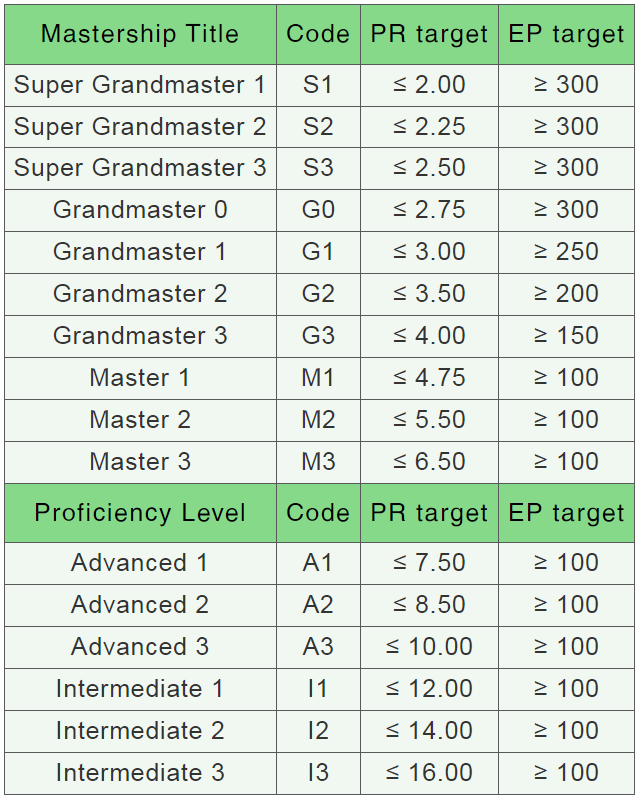
|
The lower your PR[1] gets, the harder it will be to lower it even further. We humans have the problem that we only have a limited amount of time available, which means that it is not enough to invest a lot of time in studying backgammon, we also need to do it in an efficient way. So we need to find a very effective method. After receiving my BMAB[2] title Grandmaster 1 (playing a PR below 3.0) in November 2021, I was still very ambitious to aim for the next titles such as Grandmaster 0 (PR below 2.75) and even Super Grandmaster (PR below 2.50), but I realized that this would not be so easy and indeed my PR stagnated for many months. In September 2022, I started my collaboration with my good friend Rainer Birkle, who had just developed his Anki Method (using digital flashcards). Based on my personal position database, we created many Anki decks, each deck contained 25 positions that had a common theme (e.g. 3rd roll, Leaving the Anchor, Against Backgame, etc.). I have to admit that while I really liked the method, at first I was a little skeptical about whether it would work for me personally. I'm so glad that I gave it a try, i.e. in the summer of 2023 I first started studying the decks we created for the general public. And a bit later I had Rainer create personal decks (usually based on mistakes I made in my matches). And what can I say? Only a few months later, in November 2023, I received the title Grandmaster 0 and just another few months later, in April 2024, I took another important step: Super Grandmaster 3 and just another few weeks later in July 2024 I got the Super Grandmaster 2 title. Together with Mochy I am now one of the only two Super Grandmasters in the world! Do you want to lower your PR and are you ready to work for it? Then you should definitely try Rainer's Anki Method. There is a lot of free material to get you started.
Dirk Schiemann, July 2024 [1] PR = Performance Rating, human's playing strength measured by today's best backgammon software eXtreme Gammon [2] BMAB = The Backgammon Masters Awarding Body |
|---|
Please make sure to check out my tutorials on YouTube before you start!
You may also be interested in these other Anki related videos on YouTube!
You can start your XG2Anki experience today completely free of charge. Just click on a title to download the deck. Please make sure to check out my YouTube tutorials (see above) so that you know what to do with the downloaded file(s).
Alternatively you can also get these free decks via the Get Shared Decks function in your Anki application.
| Title | # of Cards (Checker/Cube) |
Description |
|---|---|---|
| Backgammon Match Theory | 175 | This deck contains a card for each gammon value and take point in a 7-point match. For all those who, like Rainer, think that gammon values and take points are very important during a match, but don't want to calculate anything at the board, this is the optimal tool to memorize this important data. |
| Neil's Numbers | 18 | You need a backup plan for the match scores for which you have not (yet) memorized the gammon values and take points. With Neil's Numbers you can derive the match winning chances for any match score and then calculate important metrics like gammon value and take point. |
| Rainer's Personal Deck | 407 (341/66) |
This is Rainer's personal working deck. Rainer creates an Anki card for each of his
|
| Dirk's Bar Split | 25 (25/0) | This is an example of several theme decks that have been created from Super Grandmaster Dirk Schiemann's personal position database and are available for purchase. It contains 25 checker play problems where one of the options is splitting to opponent's bar point. Each card contains a link to a short video explanation by Dirk Schiemann. |
| Dirk's To Hit or not to Hit (Volume 1) free sample deck | 21 (21/0) | This deck contains 21 positions from Dirk Schiemann's new book To Hit or not to Hit. You can order this great book via his homepage. |
| Michy's Quiz Cyprus 2022 | 8 (8/0) | Michihito Kageyama was kind enough to allow the creation of an Anki deck from the eight difficult problems of his quiz at the 9th Merit Open in Cyprus 2022. |
| UBC Final 2022 | 40 (32/8) | This Anki deck was created from the UBC finals match files that Marc Brockmann Olsen was kind enough to share with the backgammon community via the Backgammon Galaxy Discord server. The deck contains all the blunders made by Sander Lylloff and Masayuki Mochizuki in the matches of the UBC final 2022. Quiz yourself with this Anki deck and find out on which of the 40 problems you would have done better than the champions. |
| UBC Final 2023 | 34 (20/14) | This Anki deck was created from the UBC finals match files that Marc Brockmann Olsen was kind enough to share with the backgammon community via the Backgammon Galaxy Discord server. The deck contains all the blunders made by Sander Lylloff and Masayuki Mochizuki in the matches of the UBC final 2023. Quiz yourself with this Anki deck and find out on which of the 34 problems you would have done better than the champions. |
| Michy's Gravity Seminar Nordic Open 2023 | 14 (14/0) | Michihito Kageyama was kind enough to allow the creation of an Anki deck from his Gravity Seminar he held at the Nordic Open 2023. |
| 1st Roll | 15 (15/0) | With this deck you can practice your opening rolls for tournament play. Each card shows the correct moves for money game, DMP, gammon-save and gammon-go! |
There are many Anki decks available for sale, e.g. Super Grandmaster Dirk Schiemann has created various theme decks from his personal position database. One example is the "Dirk's Bar Split" deck, which you can download for free (see above). Each deck contains 25 cards on a specific theme and costs 9 euros.
Unless otherwise stated, the Anki decks do not come with written or video explanations!
How to order?
Just send me the total price for the deck(s) via PayPal to rainer@xg2anki.de or via Revolut to revolut.me/xg2anki and put the code(s) of the deck(s) together with your e-mail address in the comment field of your payment. You will get the download links latest within 48 hours, usually way earlier.
| Code | Price | Title | # of Cards (Checker/Cube) |
Description |
|---|---|---|---|---|
| Mochy | 19 € | Mochy's Blunders | 261 (187/74) | I downloaded 100 Mochy matches from Backgammon Studio and created an Anki card for each of Mochy's blunders, for a total of 261 cards. Take a quiz on these difficult decisions and find out where you did better than the champion! Each cube action card has a score matrix which shows you the correct cube actions for all scores in a 7-point match. |
| TOB | 19 € | Dirk's Theory of Backgammon | 217 (48/169) | Super Grandmaster Dirk Schiemann has offered 217 positions from his book "The Theory of Backgammon" as a free download on his homepage. This Anki deck was created from these 217 positions and will certainly support you in studying his monumental masterpiece. Each cube action card has a score matrix which shows you the correct cube actions for all scores in a 7-point match. If you don't have his book yet, you should buy it NOW! It is currently available in German and English. |
| HIT1 | 19 € | Dirk's To Hit or not to Hit (Volume 1) | 227 (225/2) |
This deck contains all the positions from Super Grandmaster Dirk Schiemann's second book To Hit or not to Hit (Volume 1), which you can order via his homepage. Important: This deck Anki deck is currently only available for customers who have already purchased/ordered the book! |
| Nick | 19 € | Nick Blasier - Adjusting to Match Play | 194 (56/138) | Nick Blasier was kind enough to send me 456 XG position files from his great new book "Adjusting to Match Play" to create an Anki deck from. Each cube action card has a score matrix which shows you the correct cube actions for all scores in a 7-point match. It is the perfect companion when studying his book! Of course, Nick's explanations are very educational and a must read, so visit his website and buy his great book if you don't already have it! |
| OPRE | 19 € | 2nd Roll | 443 (443/0) | Practice your opening replies with this powerful tool. Each card shows the correct moves for money game, DMP, gammon-save and gammon-go! |
| EMC1 | 9 € | Early Match Cubes (Part 1) | 25 (0/25) | This deck contains 25 early cube decisions. Each card has a score matrix which shows you the correct cube actions for all scores in a 7-point match. |
| EMC2 | 9 € | Early Match Cubes (Part 2) | 25 (0/25) | This deck contains another 25 early cube decisions. Each card has a score matrix which shows you the correct cube actions for all scores in a 7-point match. |
| D3rd1 | 9 € | Dirk's 3rd Roll (Part 1) | 25 (25/0) | It is very important to find the correct moves in the very early stages of the game simply because these positions come up over and over again. The positions in this deck deal with typical problems in the opening, for instance: "Should I hit or rather make an important point? Should I escape with one of my back checkers or play for contact? Should I split my back checkers or should I rather try to improve my front position?" |
| D3rd2 | 9 € | Dirk's 3rd Roll (Part 2) | 25 (25/0) | More 3rd roll positions. Note that all the positions are the result of correct checker plays on the two previous moves. In that sense they are "realistic" positions. |
| D3rd3 | 9 € | Dirk's 3rd Roll (Part 3) | 25 (25/0) | 25 more 3rd roll problems. |
| D3rd4 | 9 € | Dirk's 3rd Roll (Part 4) | 25 (25/0) | 25 more 3rd roll problems. |
| D4th1 | 9 € | Dirk's 4th Roll (Part 1) | 25 (25/0) | Like in the 3rd roll positions it is your second decision of the game but, unlike before, your opponent has already made two moves which generally leads to more complex decisions. |
| D4th2 | 9 € | Dirk's 4th Roll (Part 2) | 25 (25/0) | More 4th roll positions dealing with different topics that arise in the early game. |
| D4th3 | 9 € | Dirk's 4th Roll (Part 3) | 25 (25/0) | More 4th roll positions dealing with different topics that arise in the early game. |
| D4th4 | 9 € | Dirk's 4th Roll (Part 4) | 25 (25/0) | More 4th roll positions dealing with different topics that arise in the early game. |
| D4th5 | 9 € | Dirk's 4th Roll (Part 5) | 25 (25/0) | More 4th roll positions dealing with different topics that arise in the early game. |
| D4th6 | 9 € | Dirk's 4th Roll (Part 6) | 25 (25/0) | More 4th roll positions dealing with different topics that arise in the early game. |
| DAB | 9 € | Dirk's Against Backgame | 25 (25/0) | Playing against a backgame is difficult. The positions from this deck deal with the most common problems like: "Should I hit additional checkers? Should I try to get hit in order to destroy my opponent's timing? Should I keep my prime in front of my opponent's anchors or should I start breaking it?" |
| DBI1 | 9 € | Dirk's Bear In (Part 1) | 25 (25/0) | Many avoidable mistakes are made in the late stages of the game. Typical questions in the bear-in stage are which points you should clear first, how to distribute your checkers, or whether you should take some risk to achieve more flexibility. |
| DBI2 | 9 € | Dirk's Bear In (Part 2) | 25 (25/0) | More positions to help improve your bear-in technique. |
| DBO | 9 € | Dirk's Bear Off | 25 (25/0) | With this deck you can improve you bear off technique. In some positions it is only about maximum safety while in others you have to decide how much risk you should take in order to win more gammons. |
| DCO1 | 9 € | Dirk's Contact (Part 1) | 25 (25/0) | When trailing in the race by a lot, you need to hit an opposing checker to win. It therefore desirable to create as much contact as possible. How much risk you can take in order to maximize contact is one of the main topics in this deck. |
| DCO2 | 9 € | Dirk's Contact (Part 2) | 25 (25/0) | More positions on maximizing contact and how much risk you can take in order to do so. |
| DHL | 9 € | Dirk's Hit Loose | 25 (25/0) | One of the most common decisions in backgammon is whether to hit loose in your homeboard. When the play works, you can often improve your position significantly. However, by hitting loose you expose yourself at least to a direct shot. After a return hit you will lose a lot of ground in the race and your position will deteriorate. The positions of this deck should give you a feel when taking the risk is warranted and when it is not. |
| DHLV | 20 € | Dirk's Hit Loose Video |
Video explanations by Super Grandmaster Dirk Schiemann for the Anki deck "Dirk's Hit Loose". Take a look at the free "Dirk's Bar Split" deck to see the video links in action.
Important: The tutorial video is explicitly unlocked for your YouTube account. For this, we need your email address with which you are registered at YouTube. |
|
| DHD | 9 € | Dirk's Homeboard Distribution | 25 (25/0) | When you play against XG you will notice that the machine sometimes leaves multiple blots in its home board. In other occasions, however, it avoids a blot at all costs. The deck deals with the question when to do one thing and when the other. |
| DHA1 | 9 € | Dirk's How to Attack (Part 1) | 25 (25/0) | In the positions of this deck it is clear that you should make an attacking play. The question is how to do it. Do you hit twice? Do you hit loose or play pick and pass? Do you switch points? |
| DHA2 | 9 € | Dirk's How to Attack (Part 2) | 25 (25/0) | More positions that shed a light on what is the best way to attack. |
| DHA3 | 9 € | Dirk's How to Attack (Part 3) | 25 (25/0) | Another set of positions on the topic of attacking. |
| DLA1 | 9 € | Dirk's Leaving the Anchor (Part 1) | 25 (25/0) | Establishing an advanced anchor is among the top priorities in the early game. At some point in the game, however, you will have to break your anchor and try to get your checkers home. This usually involves considerable risks, and thus makes it difficult to find the right time for abandoning the anchor. The positions in this deck illustrate the factors that influence the decision. |
| DLA2 | 9 € | Dirk's Leaving the Anchor (Part 2) | 25 (25/0) | The decision whether to leave your anchor or not comes up very often, and there are many factors to consider. This is why I made a second deck on the topic. |
| DMP | 9 € | Dirk's Midpoint | 25 (25/0) | The mid-point is a crucial link between your back checkers and the front part of your position. The topic of this deck is under which circumstances you may nevertheless need to give it up. |
| DOB | 9 € | Dirk's One Back Step Up | 25 (25/0) | Getting your lone back checker to safe territory is usually your top priority, especially when you are leading in the race. Stepping up in your opponent's home board gets the checker closer to home but comes with the risk of it being attacked. Whether you should expose yourself to the attack or whether you should stay back is the topic of this deck. |
| DPS | 9 € | Dirk's Prime Slot | 25 (25/0) | The fastest way of extending your prime is to slot the point that you want to make and cover the blot after it gets missed. By studying the positions in this deck you can get a feel for when the risk is worth the reward. |
| DWA1 | 9 € | Dirk's Whether To Attack (Part 1) | 25 (25/0) | In this deck the task it not to find the best way to attack but to decide whether you should attack at all. The decision can be very tricky, especially when you can either attack or prime your opponent. |
| DWA2 | 9 € | Dirk's Whether To Attack (Part 2) | 25 (25/0) | More positions where you have to decide whether you want to go for the attack or play quietly. |
| DWA3 | 9 € | Dirk's Whether To Attack (Part 3) | 25 (25/0) | Another set of postions on this difficult topic. |
| DWP | 9 € | Dirk's Which Point | 25 (25/0) | It frequently happens that you have the choice between different important points. For example, you could either make an advanced anchor or a good inner board point. Once you have mastered the positions from this deck, you should have a good idea which factors to consider. |
You can use the XG2Anki service to get a personal Anki deck created from your XG match and/or position files!
Individual decks by default do not include match score matrixes!
This is a very straightforward way: you create an XG position file for each Anki card you want to get created. You can even add comments in XG, which are then transferred to the Anki card (plain text, without formatting). Make sure that you are already analyzing the position on the level that should later appear on the Anki card (XG++ or rollouts are recommended).
It is also possible to automatically add comparable positions to an Anki card by naming the XG position files according a specific naming convention, here is an example:
You can also send complete matches and set the following thresholds (milli point limits):
As an alternative (or addition) to defining the three thresholds cards can get created for flagged positions or positions that contain a comment.
You can even define that a position gets ignored (so that no Anki card will get created for this position) by adding the text NoAnki somewhere in the comment field. This may be useful for oversights or repeating errors!
Make sure that you are always the player on the bottom and that you are already analyzing the match on the level that should later appear on the Anki card (XG++ or rollouts are recommended).
Just select one of the packages below and send me the money via PayPal to rainer@xg2anki.de or via Revolut to revolut.me/xg2anki and put the code of your package together with your e-mail address in the comment field of your payment.
You can then send XG position/match files until your Anki credits have been used up. You will normally receive your new deck within a few days. If there is a lot going on at a particular time, it can take a little longer.
Basic Card = 1 Anki Credit / DeLuxe Card = 2 Anki Credits
Pro Tip: If you play matches regularly, the DeLuxe version is highly recommended. If you are hesitating because of the higher price, you should consider buying fewer DeLuxe cards rather than a larger number of Basic cards!
Since the creation of match score matrixes is quite time-consuming, it is hardly practical and/or too expensive for individual decks. For all those who are still interested, here are the match score matrix surcharges:
| Code | Price | Title | Price per Anki Credit |
|---|---|---|---|
| ID50 | 20 € | 50 Anki Credits Package | 40 ¢ |
| ID100 | 35 € | 100 Anki Credits Package | 35 ¢ |
| ID200 | 60 € | 200 Anki Credits Package | 30 ¢ |
| ID500 | 125 € | 500 Anki Credits Package | 25 ¢ |
| ID1000 | 200 € | 1000 Anki Credits Package | 20 ¢ |
You can influence the way each deck works via the following parameters, which you can specify in square brackets at the end of the deck name (by renaming your deck):
| Parameter | Description |
|---|---|
| a | display match score as absolute instead of relative |
| b | display match score as absolute AND relative (instead of just relative) |
| c | hide extra data for checker play decisions (Neutral Score, Double Match Point, Gammon-Save & Gammon-Go) |
| d | immediately show dice distribution information (instead of via button) |
| e | immediately show comparable situation(s) (instead of via button) |
| f | immediately show an additional small position diagramm at a fixed position in the upper right corner (instead of via clicking/tapping on the position diagram) |
| g | don't repeat the original position in section with comparable situation(s) |
| h | hide appendix (extra information on the back side of a card) |
| i | hide player info (don't show player and file names) |
| j | initially hide the results for comparable situations (in order to display them later manually by clicking on the diagram of the comparable situation) |
| l | immediately show large XG result graphics (instead of via clicking/tapping on the graphics) |
| m | hide money game info |
| n | show names of the players below the position diagram |
| p | turn on pipcount trainer |
| q | hide multiple choice list |
| r | show roll in title |
| s | scroll down to results automatically when showing the answer |
| t | hide title |
| u | use player names instead of Black & White |
| v | autoplay video |
| x | show criss-cross count calculation button on front side |
| y | show XGID and copy button on front side as well |
| znn | zoom position diagram (e.g. "z40" = shrink position diagram to 50% of the screen width) |
| Znn | zoom comparable situation (e.g. "Z50" = shrink comparable situation to 50% of the screen width) |
You can set several parameters by separating them with a semicolon.
Examples:
My Deck Name [p]
My Deck Name [p;c]
General Tip: Please make sure that you are always using the latest Anki version!
Here is a list of frequently asked questions. Please check it out before asking for support. Thanks.
If you still have issues/questions after reading the following FAQ section, you can contact Rainer by e-mail (rainer@xg2anki.de) or Facebook.
By default Anki offers you 20 new cards per deck every day. The easiest way to check how many cards a deck contains is this:
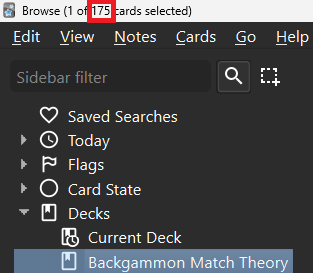
Please do never import an Anki deck directly on your mobile device! Instead please always import the Anki deck via your Anki desktop application and then transfer the deck to your mobile device via Anki synchronization!
Please do never import an Anki deck directly on your mobile device! Instead please always import the Anki deck via your Anki desktop application and then transfer the deck to your mobile device via Anki synchronization!
If images are still missing after Anki synchronization you should repeat the synchronization later (most likely the image upload from your desktop has not been completed yet)!
It's very important that you wait until the syncronization has really finished on your desktop device before you start the syncronization on your mobile device.
 Make sure that the animated round arrow icon has disappeared before you start the syncronization on another device!
Make sure that the animated round arrow icon has disappeared before you start the syncronization on another device!
And also take care that the animation below the round arrow syncronization icon has disappeared before you open any cards!
Please make sure that you use the following settings when importing a deck:
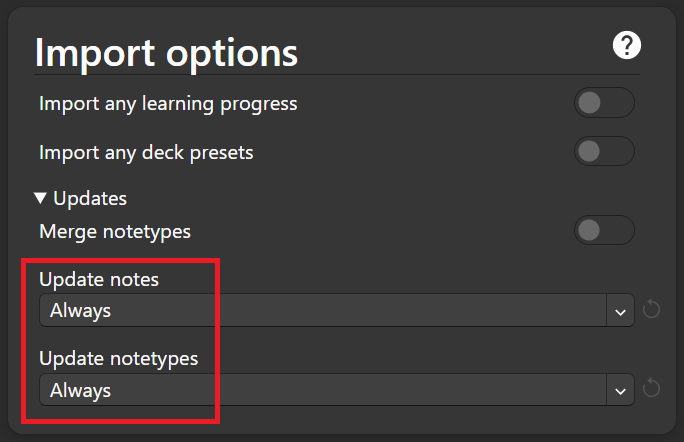
If the issue remains, please delete the deck and import the deck again.
Anki allows you to easily move cards from one deck to another. Select all cards from a deck in the browse window by clicking on the first card and shift clicking on the last card, then open the context menu with a right click and click on Change Deck... and in the upcoming dialog you select the target deck and click on Move Cards.
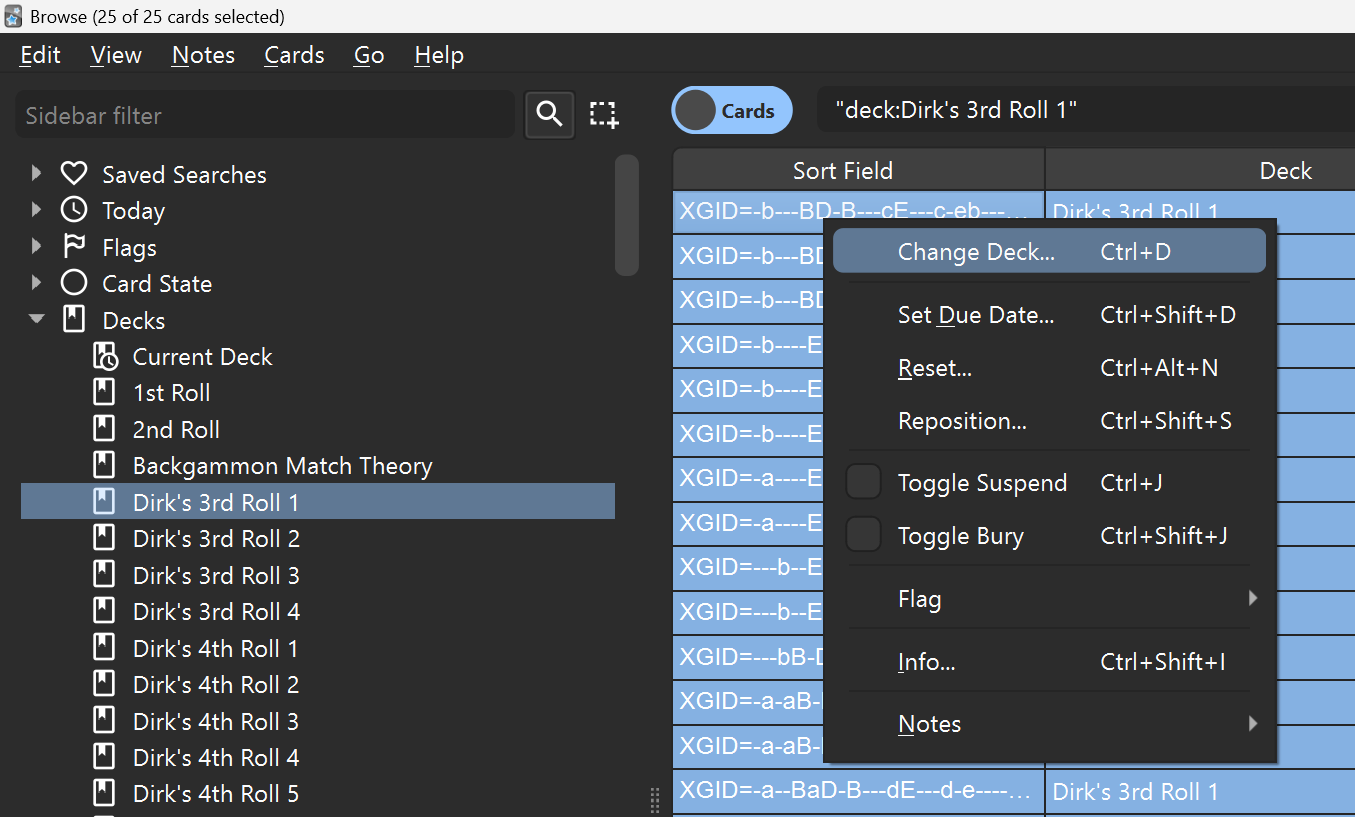
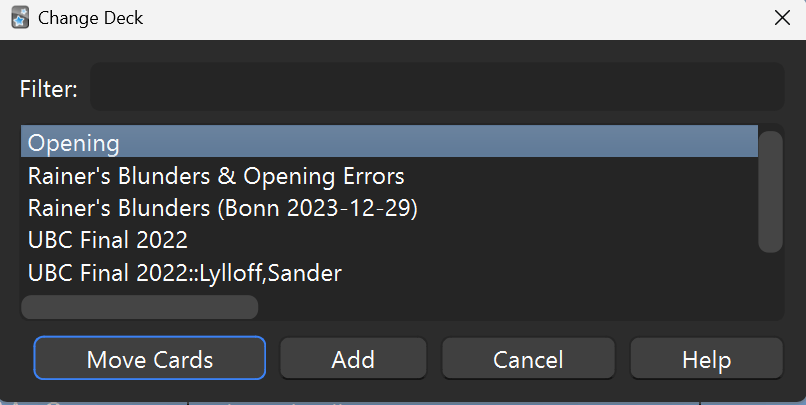
Alternatively you can move the cards to a new deck by clicking on Add instead of on Move Cards. Just enter the name of the new deck and press OK.

Rainer offers individual Anki powered backgammon coaching face to face or via ZOOM. In the case of ZOOM, the session is always recorded and is available as an unlisted YouTube video so that the trainee can watch it again later as often as he wants/needs.
Unique features of Rainer's backgammon coaching:
If you are interested in private lessons in general, you should definitely take a look at this page: 
Rainer Birkle
Weinheimer Straße 6g
69488 Birkenau
Phone: +49 (0) 6201 - 3893381
E-Mail: rainer@xg2anki.de
Rainer Birkle
Weinheimer Straße 6g
69488 Birkenau
The contents of our website have been created with the greatest possible care. However, we cannot guarantee the contents' accuracy, completeness, or topicality. According to Section 7, paragraph 1 of the TMG (Telemediengesetz - German Telemedia Act), we as service providers are liable for our content on these pages by general laws. However, according to Sections 8 to 10 of the TMG, we service providers are not obliged to monitor external information transmitted or stored or investigate circumstances pointing to illegal activity. Obligations to remove or block the use of information under general laws remain unaffected. However, a liability in this regard is only possible from the moment of knowledge of a specific infringement. Upon notification of such violations, we will remove the content immediately.
Our website contains links to external websites, over whose contents we have no control. Therefore, we cannot accept any liability for these external contents. The respective provider or operator of the websites is always responsible for the contents of the linked pages. The linked pages were checked for possible legal violations at the time of linking. Illegal contents were not identified at the time of linking. However, permanent monitoring of the contents of the linked pages is not reasonable without specific indications of a violation. Upon notification of violations, we will remove such links immediately.
The contents and works on these pages created by the site operator are subject to German copyright law. The duplication, processing, distribution, and any kind of utilization outside the limits of copyright require the written consent of the respective author or creator. Downloads and copies of these pages are only permitted for private, non-commercial use. In so far as the contents on this site were not created by the operator, the copyrights of third parties are respected. In particular, third-party content is marked as such. Should you become aware of a copyright infringement, please inform us accordingly. Upon notification of violations, we will remove such contents immediately.
Last Updated: 2024-03-24
 |
The Anki MethodXG2Anki |

|
|---|